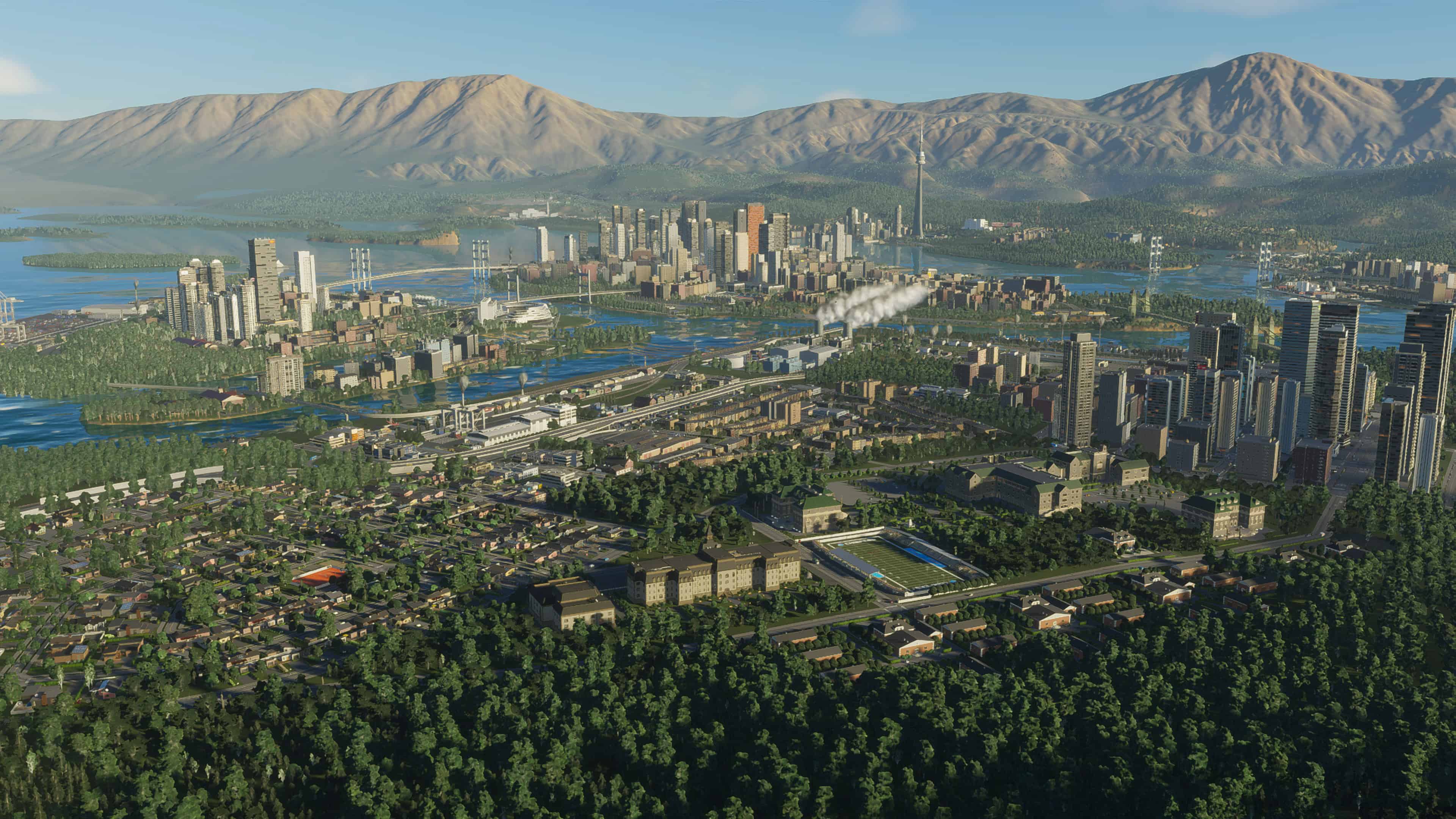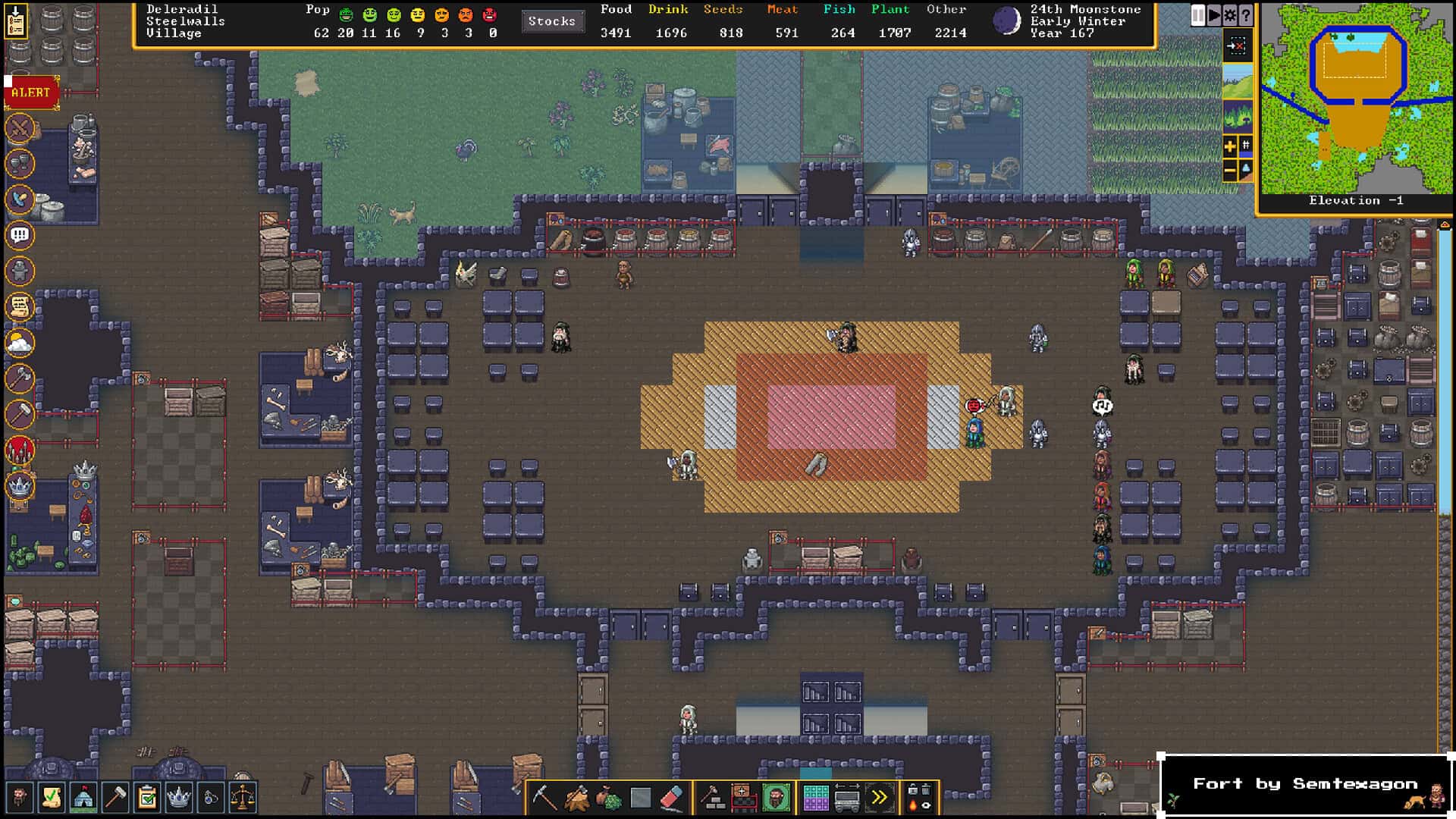City builder games let players create and manage virtual towns, cities, or settlements. They mix strategy and creativity as you plan layouts, manage resources, and watch your creation grow. The best city builder games balance challenge with fun, giving players both complex systems to master and the satisfaction of seeing their vision come to life.
These games have been popular for decades, from early classics to modern titles with detailed graphics. Some focus on historical settings while others explore futuristic worlds or fantasy realms. They appeal to many players because they can be played at your own pace and offer different ways to succeed.
Best City Builder Games
City builders have evolved far beyond the grid-based foundations of SimCity. In 2025, the genre is more alive than ever, blending complex simulation, gorgeous visuals, and unique survival or management twists. Whether you’re into sprawling metropolises, cozy villages, or sci-fi colonies, there’s something for every type of planner this year.
Here are the best city builder games you can play in 2025:
1. Cities: Skylines II

Platform: PC, Xbox Series X|S, PS5 (with ongoing optimization updates)
Why It’s Great:
Still the most ambitious modern city sim, now with deeper economic systems and detailed citizen behavior.
Key Features:
- Dynamic weather & climate systems
- Expanded traffic AI
- Modding support (still growing)
- Customizable building tools
Paradox Interactive continues refining Cities: Skylines II with frequent patches. It launched with some performance issues in 2023, but 2025 updates have dramatically improved simulation speed, mod integration, and public transportation systems. It remains the go-to for realism and large-scale urban management.
2. Manor Lords
Platform: PC (Steam Early Access)
Why It’s Great:
A medieval city builder with Total War-style battles and unprecedented attention to realism.
Key Features:
- Organic settlement layout
- Deep trade and resource economy
- Real-time combat
- Seasonal farming cycles
Manor Lords offers a grounded, tactical spin on city building. You aren’t just planning layouts—you’re managing families, defending borders, and surviving winter. Its Early Access phase has proven wildly successful, thanks to its cinematic visuals and satisfying village growth loop.
Manor Lords has taken the city-builder genre by storm with its unique blend of medieval town building and strategic combat. Released in 2024, this game stands out by combining detailed city construction with tactical battles in a historically-inspired medieval setting.
The game’s authentic approach to medieval city building is immediately noticeable. Unlike other titles in the genre, Manor Lords uses a grid-free building system that allows for organic town layouts that follow the natural terrain. Players manage not just buildings but entire communities. The economic simulation tracks individual villagers and their needs, creating a deep connection to your growing settlement. Each family unit works, lives, and contributes to your medieval society.
The visual presentation deserves special mention. Impeccable atmosphere helps transport players back to a simpler time, with stunning visuals that bring the medieval period to life through changing seasons and detailed environments.
Combat adds another dimension to the experience. While the game leans more toward Anno than Total War, the battles provide meaningful strategic challenges that integrate well with the city-building aspects.
The economic systems show impressive depth. Players must manage production chains, trade, and regional resources while balancing the needs of their growing population. This complexity creates meaningful choices without becoming overwhelming. Manor Lords supports different play styles too. You can focus on creating a peaceful, prosperous settlement or build up military might to expand your territory through conquest.
The game’s development continues with regular updates. The developer actively engages with the community and has already implemented several major updates since its early access launch. Manor Lords has quickly established itself as one of the most compelling medieval city builders available today, earning praise for its authentic approach and engaging gameplay systems.
3. Frostpunk 2
Platform: PC, Xbox Series X|S, PS5 (coming Q3 2025)
Why It’s Great:
Brutal city-building meets moral decision-making in a frozen world on the brink.
Key Features:
- Narrative-driven campaign
- Expanded societal systems (factions, ideology)
- Resource crises and ethical dilemmas
- High-stakes policy setting
11 bit studios ups the ante with Frostpunk 2. Set decades after the original, you now manage a much larger city while navigating political infighting, faction loyalty, and inevitable scarcity. It’s less sandbox, more survival strategy—but one of the most emotionally intense city builders out there.
4. Farthest Frontier
Platform: PC
Why It’s Great:
A low-fantasy, highly detailed survival city builder with intricate production chains and disease mechanics.
Key Features:
- Deep farming and food systems
- Challenging terrain and weather
- Micromanagement of individual villagers
- Defensive structure building
Farthest Frontier hits a sweet spot between realism and accessibility. It rewards meticulous planning, especially when your crops fail or invaders threaten your progress. 2025 updates have added new difficulty modes, quality-of-life features, and improved AI.
5. Against the Storm
Platform: PC, Xbox
Why It’s Great:
Roguelike city-building—each run has different conditions, rewards, and settlements to manage.
Key Features:
- Multiple fantasy races with unique needs
- Time-limited cycles
- Persistent meta-progression
- Beautifully stylized visuals
This is one of the most creative takes on city-building. You’re rebuilding civilization in a world of endless storms, constantly balancing risk and reward. It’s quick, addictive, and deeply strategic.
6. Anno 1800
Platform: PC, PS5, Xbox Series X|S
Why It’s Great:
Still unmatched in terms of trade networks and production chains in an industrial-era setting.
Key Features:
- Intercontinental trade
- Tourism and diplomacy
- Beautiful islands and sprawling cities
- Dozens of DLCs (Sunken Treasures, New World Rising, etc.)
Even six years post-launch, Anno 1800 remains a masterpiece. The console version holds up well, but PC players still get the best experience thanks to UI flexibility and mod support.
Anno 1800 stands out as one of the most impressive city builders of recent years. Set during the Industrial Revolution, it challenges players to build and manage cities across multiple islands. The game offers a perfect blend of city planning and resource management. Players must satisfy the needs of different social classes while establishing trade routes between islands to ensure proper supply chains. What makes Anno 1800 special is its attention to detail. The buildings are beautifully designed, and watching your city grow from a small settlement to a bustling metropolis is truly satisfying. Unlike many city builders, Anno 1800 features both a campaign mode and a sandbox experience. This gives players freedom to play how they want, whether following a story or creating without restrictions.
The game has been called one of the only good city building games released in recent years by some enthusiasts. Its depth and complexity set it apart from competitors. Anno 1800 includes an interesting concept similar to the 15-minute city planning principle, where essential needs should be available within a short distance. This adds a layer of strategy to city layouts. The game isn’t for everyone. Its learning curve can be steep for newcomers to the genre, but those who enjoy city builders will likely find enjoyment in Anno 1800.
Trade is a core element of gameplay. Players must establish shipping routes between their islands and AI civilizations to ensure their citizens have everything they need. The DLC expansions add substantial content to the base game, including new regions, buildings, and mechanics. This has kept the game fresh years after its initial release.
7. Terra Nil
Platform: PC, Switch, Mobile
Why It’s Great:
A reverse city builder where you restore the environment instead of exploiting it.
Key Features:
- Rewilding instead of urbanization
- Atmospheric, meditative gameplay
- Environmental puzzle mechanics
- Stunning hand-painted visuals
A relaxing, eco-conscious entry in a genre known for expansionism. Terra Nil flips the formula and makes undoing damage feel just as rewarding as constructing buildings.
8. Settlement Survival
Platform: PC, Xbox
Why It’s Great:
Banished-style survival building with lots of production depth and random world generation.
Key Features:
- Migration systems
- Disease, starvation, and disaster events
- Skill trees and policies
- Trade & tech progression
It’s a sleeper hit for players who miss the hardcore survival loop of older games. The visuals aren’t flashy, but the systems are tightly designed and endlessly engaging.
9. The Wandering Village
Platform: PC, Xbox
Why It’s Great:
Build your city on the back of a giant, living creature—while managing both the village and the beast.
Key Features:
- Dual-layer management (village + creature)
- Biome shifts and toxicity events
- Stylized art direction
- Survival elements
This one stands out for its concept alone. You must earn the trust of your massive companion while protecting your people from external threats. It’s equal parts charming and strategic.
10. Pharaoh: A New Era
Platform: PC
Why It’s Great:
A full remake of the classic Pharaoh (1999), now with a modern UI and refreshed art.
Key Features:
- Ancient Egyptian setting
- Monument construction (like pyramids)
- Religion, culture, and trade systems
- Historical campaigns
Nostalgia meets modernization. While it’s faithful to the original in gameplay flow, the updated interface and mechanics make it easier to enjoy in 2025.
If you’re looking for city-building games with high replayability, depth, and thematic richness, 2025 delivers across the board—from frigid survival to cozy simulation to genre-bending hybrids.
11. Dwarf Fortress
Dwarf Fortress stands as the undisputed champion of city builders according to many gaming enthusiasts. This deep simulation game offers players an unmatched level of detail and complexity that few other titles can rival.
The game combines city building with colony management in a fantasy world that’s completely unique each time you play. Your job is to help a group of dwarves build and maintain a mountain fortress while facing numerous challenges.
What makes Dwarf Fortress special is its incredible depth. The game simulates everything from individual dwarf personalities to the specific materials of each crafted item. Each dwarf has preferences, relationships, and emotional states that affect how they work and interact.
The learning curve is steep, but the reward is worth it. The game’s unofficial motto, “Losing is fun,” hints at the inevitable challenges you’ll face. Whether it’s a goblin invasion or your dwarves going mad from poor living conditions, each failure tells a story.
In 2022, Dwarf Fortress received a major update with improved graphics and a more accessible interface on Steam. This version made the game more approachable while keeping the deep simulation that dedicated fans love.
The game has inspired many other titles in the genre. It’s often mentioned alongside RimWorld and the Anno series as one of the most influential city builders ever made.
Dwarf Fortress has earned its reputation as a painstakingly crafted, deeply nerdy passion project. The two-brother development team has been working on it since 2003, with no end in sight for new features and improvements.
For those who enjoy endless city builders, few games offer the replayability of Dwarf Fortress. Each world is procedurally generated with unique geography, history, and civilizations, ensuring no two playthroughs are alike.
12. RimWorld
RimWorld is a sci-fi colony sim that puts players in charge of managing survivors on a distant planet. The game is driven by an intelligent AI storyteller that creates events and challenges that keep gameplay fresh and unpredictable.
Unlike traditional city builders, RimWorld focuses on small-scale colony management with deep character simulations. Each colonist has unique traits, skills, and relationships that affect how they interact with others and perform tasks.
The game draws inspiration from classic works like Dwarf Fortress, Firefly, and Dune. Players start with just three survivors who must build shelter, grow food, and defend against threats ranging from hostile raiders to deadly weather conditions.
What makes RimWorld stand out is its emergent storytelling. No two playthroughs are ever the same. The AI director adjusts difficulty based on your colony’s situation, ensuring constant engagement without becoming overwhelming.
The game’s modding community is exceptional, offering thousands of additions that can transform the game. While it began as a sci-fi colony builder, mods can shift the setting to medieval times, fantasy worlds, or other unique scenarios.
Resource management forms the core gameplay loop. Players must balance food production, power generation, and manufacturing while keeping colonists happy and healthy. The game doesn’t shy away from harsh realities—colonists can suffer mental breaks if their needs aren’t met.
Combat plays a significant role as players defend their colony from various threats. Strategic placement of defenses and smart management of fighters becomes crucial for survival.
RimWorld offers tremendous depth without overwhelming new players. The intuitive interface makes basic functions accessible while allowing for complex strategies as players gain experience.
The game continues to receive updates and has expansions that add new content and mechanics. For players who enjoy colony management with rich storytelling, RimWorld delivers one of the most engaging experiences in the genre.
13. SimCity 4
SimCity 4 remains the greatest citybuilder of all time even 20 years after its release. The game’s incredible depth lets players create detailed urban landscapes with remarkable control over zoning, utilities, and public services.
What makes SimCity 4 special is its robust economic simulation. Players must balance budgets and manage resources while growing their cities. The tax system allows for different rates across residential, commercial, and industrial zones, adding a layer of strategy to city management.
The Rush Hour expansion improved the game significantly by adding transportation options and more detailed traffic simulation. Players can build intricate highway systems, subway networks, and bus routes to keep citizens moving efficiently.
SimCity 4’s graphics hold up surprisingly well for a game from 2003. The isometric view provides clear visibility of the entire city while still showing impressive details when zoomed in on neighborhoods.
The game features three development densities – low, medium, and high – giving players flexibility in how they design their urban spaces. Many fans still prefer the gridded city design that SimCity 4 excels at compared to newer city builders.
Perhaps the most impressive aspect of SimCity 4 is its modding community. Thousands of user-created buildings, maps, and gameplay modifications have extended the game’s lifespan well beyond expectations.
Players can connect multiple cities in regions, creating interconnected metropolitan areas that share resources and population. This regional play adds another dimension to the game’s already deep systems.
After two decades, many city-building enthusiasts still believe we haven’t seen another game as realistic and complex as SimCity 4. Its combination of accessibility and depth makes it approachable for beginners while providing enough complexity for veterans.
14. Caesar 3
Caesar 3 stands as a cornerstone in the city-building genre, released in 1998 but still beloved by many fans today. The game puts you in charge of a Roman settlement that you must grow into a thriving city while keeping citizens happy and resources flowing.
What makes Caesar 3 special is its perfect mix of simplicity and depth. You build roads, houses, and services while managing water, food, and entertainment for your citizens. Each element connects in ways that create interesting challenges.
The game uses a “walker” system where services work through people who travel your city’s roads. This means your city layout really matters – poorly planned streets can leave neighborhoods without key services.
Caesar 3 is known for its excellent music, graphics and gameplay compared to other titles in the series. Many players consider it the best entry point before trying later city builders.
The game has aged remarkably well, with fans creating patches and modifications to make it run on modern systems. Some projects even add quality-of-life improvements while keeping the core gameplay intact.
Caesar 3 influenced many later city builders with its economic chains and citizen evolution mechanics. Houses upgrade as you provide better services, creating a satisfying progression system.
Despite its age, Caesar 3 remains popular enough that newer games like Citadelum explicitly model themselves after it, trying to capture that special blend of accessibility and depth.
For players new to city builders, Caesar 3 offers clear objectives through its campaign mode while still allowing creative freedom. The mission-based structure gives a sense of purpose that some modern sandbox builders lack.
Though City Skylines is considered the best modern city builder, many still return to Caesar 3 for its unique charm and focused gameplay that captures the essence of Roman city planning.
15. Tropico 6
Tropico 6 stands out as a unique entry in the city-building genre. In this game, players take on the role of El Presidente, ruling a Caribbean island through different eras from colonial times to modern day.
Unlike traditional city builders, Tropico 6 adds political simulation to the mix. Players must balance the needs of different factions while managing the economy, military, and international relations.
The game features a neat building system where roads connect smoothly. This makes city planning more intuitive compared to some competitors where road placement can be frustrating.
Tropico 6 is known for its humor and satirical take on politics. The game doesn’t take itself too seriously, poking fun at different political systems while still offering meaningful gameplay choices.
Resource management plays a key role in Tropico’s gameplay. Players must develop industries, manage trade routes, and ensure citizens have their basic needs met to prevent uprisings.
While Cities: Skylines offers more detailed and realistic city building, Tropico 6 shines with its character and political elements. The game gives players more direct control over individual citizens and buildings.
Critics have praised Tropico 6, with Windows Central calling it one of the best city-building simulators ever. The game earned a 4.5/5 rating from the publication.
The archipelago system sets Tropico 6 apart from earlier entries. Players can build across multiple islands, adding strategic depth to expansion and resource management.
Tourism remains an important aspect of the Tropico economy. Creating attractive resorts, entertainment venues, and landmarks helps bring in foreign currency to fund infrastructure projects.
Despite its comical approach, Tropico 6 deals with serious themes of governance. Players face genuine challenges balancing freedom, prosperity, and control while maintaining power on their island paradise.
16. Cities: Skylines
Cities: Skylines has become a dominant force in the city-building genre since its release. Many gamers consider it the reigning champion of city builders by a significant margin.
The game excels in several areas where other titles fall short. It offers impressive visuals, larger building scales, and more complex construction options compared to its competitors. One of its strongest features is the realistic traffic simulation, which adds a layer of authenticity to the urban planning experience.
Players appreciate the game’s depth while maintaining accessibility. The learning curve feels balanced – challenging enough for veterans but not overwhelming for newcomers.
Cities: Skylines outshines many aspects of older titles like SimCity 4, particularly in terms of scale and traffic simulation. The modern graphics and smoother gameplay experience attract players who want a contemporary city-building experience.
The game offers extensive customization through a robust modding community. Players can download thousands of assets, from buildings to transportation options, drastically expanding the base game’s possibilities.
Where Cities: Skylines sometimes falls short is in capturing the whimsy and fun that made earlier city builders so engaging. Some players note that it lacks the charm and engagement that games like SimCity provided.
The expansion packs add significant value, introducing new mechanics like seasons, natural disasters, and industries. These additions keep the gameplay fresh even years after release.
As city-building games continue to evolve, Cities: Skylines remains the benchmark that newer titles must measure up against. Its balance of detailed simulation and accessible gameplay keeps players coming back to build their dream cities.
17. Banished
Banished stands out from typical city builders with its focus on survival rather than expansion. In this game, you manage a small group of exiles who must build a new settlement from scratch in a harsh environment.
Unlike many city builders that emphasize growth and technology, Banished keeps things simple yet challenging. Players must carefully balance resources to keep their villagers alive through changing seasons and potential disasters.
The game has no tech trees or complex political systems. Instead, it focuses on the basics: food, shelter, clothing, and tools. This stripped-down approach creates a tense experience where one bad winter can spell doom for your community.
Resource management is key in Banished. You’ll need to plan carefully to ensure your people have enough to eat year-round. Farming, hunting, gathering, and fishing all provide food in different ways and with various challenges.
Weather plays a major role in your success or failure. Harsh winters can kill crops and citizens, while good growing seasons might give you a chance to build up reserves.
The modest scale of Banished gives it a personal feel that larger city builders often lack. You’ll know each building and resource area intimately as you struggle to keep your population alive.
For many players, Banished rekindled interest in the city-building genre with its fresh take on settlement management. Its focus on survival adds tension that many traditional city builders lack.
The game launched in 2014 but maintains a dedicated following. Many fans appreciate how it differs from typical city builder games with its survival elements and intimate scale.
Fans of Banished often seek out similar games that combine city building with survival mechanics. Its influence can be seen in newer titles that blend these genres.
18. Workers & Resources: Soviet Republic
Workers & Resources: Soviet Republic stands out as one of the most realistic city builders available today. Unlike many games in this genre, it combines city building with complex transport and logistics systems.
The game challenges players to transform an impoverished country into an industrial superpower. You must manage intricate production chains in a fully simulated economy. This adds a layer of complexity that casual city builders simply don’t offer.
Many players compare it to a mix between a traditional city builder and games like Transport Tycoon or Factorio. The logistics and transport elements are deeply integrated with city planning, creating a unique gameplay experience.
The visual style accurately captures Soviet-era architecture and industrial design. Cities you create look believably Eastern Bloc, with functional rather than purely aesthetic design choices dominating the landscape.
What sets this game apart is its commitment to realism. The simulation accounts for everything from power distribution to worker education levels. Resources must be physically transported across your republic, creating genuine logistical challenges.
Players who enjoy Workers & Resources typically praise its depth and complexity. The learning curve is steep, but those who invest the time find an incredibly absorbing planning experience.
The game continues to receive updates, adding features and improving existing systems. While not for everyone, players seeking a serious city-building challenge will find this title particularly rewarding.
Understanding the Appeal of City Builder Games
City builder games attract players with a unique blend of creativity and strategy. They offer a playground where you can design and manage virtual cities while solving complex problems.
Creative Freedom and Challenges
City builder games give players incredible creative freedom to build entire cities from scratch. The satisfaction comes from watching your creation grow from empty land into a bustling metropolis.
Players can experiment with different layouts, architectural styles, and city plans without real-world constraints. This creative aspect appeals to those who enjoy expressing themselves through design and problem-solving.
What makes these games special is how they make cities feel “lived in” with virtual citizens going about their daily routines. These citizens respond to player decisions, adding a layer of realism and consequence to every choice.
Unlike many other game genres, city builders typically have no win condition, allowing for endless playtime and experimentation. This open-ended nature keeps players engaged for hundreds of hours.
Strategic Planning and Management
The strategic elements of city builders challenge players to balance multiple systems simultaneously. Resource management, economy, citizen happiness, and infrastructure all require careful attention.
Players must think several steps ahead, planning for future growth while managing current needs. This creates a satisfying puzzle that rewards thoughtful decision-making.
Different games emphasize various strategic elements. Some focus on workflow management, while others highlight resource exchanges or economic systems.
The best city builders create tension between competing priorities. Should you build more housing or focus on industrial development? Upgrade roads or improve public services? These meaningful choices keep the gameplay engaging.
Players often develop their own goals and metrics for success, whether it’s building the most efficient city or creating the most beautiful one. This freedom to define success adds to the genre’s appeal.
Evolution of City Builder Games
City builder games have transformed dramatically since their beginnings, changing with both technology and player expectations. These games have evolved from simple grid-based simulations to complex virtual worlds with realistic economics and physics.
From SimCity to Modern Titles
The city builder genre began with Will Wright’s SimCity in 1989, which established core mechanics like zoning, infrastructure management, and budget balancing. This groundbreaking title showed players could find fun in urban planning and management.
In the 1990s, games like Caesar and Pharaoh by Impressions Games added historical settings and new challenges. The early 2000s saw the rise of 3D environments with SimCity 4 and City Life improving visual presentation.
The 2010s brought indie innovations with Banished focusing on survival and Cities: Skylines overtaking SimCity as the genre leader. Players now wanted deeper simulation and mod support.
Today’s market includes diverse options like games spanning various time periods, from prehistoric times in Dawn of Man to medieval settings in Manor Lords.
Technological Advancements and Innovations
Technical improvements have dramatically changed city builders over the decades. Early games used simple 2D sprites and limited simulation, while modern titles feature detailed 3D models, realistic lighting, and complex AI.
The biggest advancement came in simulation depth. Modern city builders calculate complex systems:
- Traffic simulations tracking individual vehicles
- Economic models with supply chains and global markets
- Environmental systems including pollution and climate effects
- Population AI with individual citizens making decisions
Cloud computing has enabled larger maps and more detailed simulations. Games like Cities: Skylines II push hardware limits with thousands of simulated citizens.
Recent innovations include procedural generation creating unique landscapes and eco-focused gameplay in titles like Timberborn. Virtual reality options are emerging, letting players experience their creations from street level.
Frequently Asked Questions
City builder games have evolved significantly over the years with options now available across multiple platforms. Players can choose from classic titles that defined the genre or newer games with innovative features.
What are the top-rated city builder games for PC in 2025?
The PC platform continues to dominate the city builder genre with several standout titles. RimWorld remains a fan favorite for its deep colony management systems and storytelling capabilities.
SimCity 4, despite its age, still holds up as one of the best city builders due to its robust simulation and active modding community.
Newer entries like Cities: Skylines II have built upon their predecessors with improved traffic management and more realistic city dynamics.
Which city building games on Android come highly recommended by the gaming community?
Pocket City ranks highly among mobile city builders for offering a premium experience without aggressive monetization. It provides depth similar to PC titles but optimized for touchscreens.
TheoTown has gained popularity for its pixel art style and surprising complexity, allowing players to create detailed urban landscapes on the go.
Tropico has successfully made the jump to mobile, bringing its signature political simulation and humor to Android devices.
What are the most compelling free city building games currently available?
Cities: Skylines has periodically been offered for free on various platforms and provides an excellent entry point into the genre with its accessible mechanics.
OpenTTD, an open-source transport and city development game, costs nothing to play while offering deep systems for managing infrastructure.
Some free mobile options like Township offer city building elements combined with farming mechanics, though they typically include optional in-app purchases.
Can you list the best city builder games for iOS with high replay value?
Pocket City stands out on iOS for its one-time purchase model and regular updates that add new features and scenarios.
TheoTown on iOS mirrors its Android counterpart with excellent performance and customization options that keep players engaged for months.
Transport-focused games like Mini Metro provide a more abstract take on city planning with procedurally generated maps ensuring no two games feel the same.
Which titles are considered classics in the city builder game genre?
SimCity 4 is widely regarded as the definitive classic city builder, setting standards for simulation depth that games still aspire to match today.
Caesar 3 remains beloved for its Roman city-building focus and challenging economic balancing, inspiring many historical city builders that followed.
Dwarf Fortress, while technically a colony simulator, has influenced countless city builders with its emergent gameplay and attention to detail.
What are the newest innovations in city building games for mobile platforms?
Augmented reality features are beginning to appear in mobile city builders, allowing players to place their virtual cities in real-world spaces and interact with them in new ways.
Cloud save integration across devices has become standard, enabling seamless transitions between playing on phones and tablets.
Some newer titles are implementing machine learning to create more realistic citizen behaviors and traffic patterns that adapt to player-built infrastructure.







